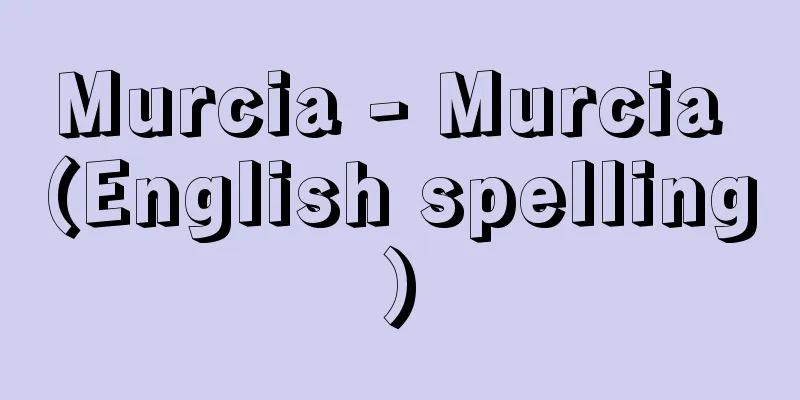Murcia - Murcia (English spelling)

|
Murcia is the capital of the province of Murcia, and the central city of the Murcia region in southeastern Spain. It has a population of 370,745 (2001). It is located in the center of the valley plain near where the Segura River, which flows southeast, turns northeast downstream. The valley plain is wide, at its widest point of 8.5 kilometers, but it is a fertile plain with many irrigation channels. Citrus fruits, mainly lemons, other fruits, grains, potatoes, vegetables, cotton, etc. are cultivated, and Murcia is a distribution center for them. Murcia produces 40% of the lemons and apricots in the country. Silk farming has also been practiced since ancient times, and the silk weaving industry flourished in the Islamic era. There is a raw silk research institute in La Alberga, 5 kilometers southwest. Currently, in addition to the textile industry, factories for canning, papermaking, woodworking, etc. are located in the urban area. The old town is on the left bank, but the new town spreads out on the opposite bank and along the railway and roads. It is home to the University of Murcia (founded in 1915), the Bishop's residence and the Episcopal Palace, and the Cathedral of Santa Maria, which dates back to the 14th century, and whose west façade is a prime example of 18th century Baroque style. Murcia is one of the historical regional names remaining in Spain, and is currently an autonomous region with an area of 11,317 square kilometers and a population of 1,562,481 (2001). It is made up of two provinces, Murcia and Albacete, which occupies the inland mountainous region to the north, and together with Valencia, it is in the southern part of the broader Levante region. It has a Mediterranean climate with extreme dryness, and the main vegetation is steppe, with Muscat grapes, almonds, figs, and other crops cultivated on the mountain slopes, and irrigated fields for fruit trees and vegetables distributed along the river plains. [Yutaka Tanabe and Yumiko Takizawa] historyThe coastal region was first colonized by the Phoenicians, who exploited its mineral resources and built Carthago Nova (present-day Cartagena) as a port. In the 3rd century BC, it was conquered by Rome during the Punic Wars, but was later invaded by the Vandals, the Byzantine Empire, and the Visigoths, and came under Muslim control in the 8th century. Initially it belonged to the Caliphate of Cordoba, but after its collapse it was included in the governorates of Almeria and Valencia, and in the 11th and 12th centuries the independent Kingdom of Murcia was formed. In the early 13th century it was briefly ruled by the Almohads, but during the period of Muslim rule it flourished as one of Spain's leading agricultural regions thanks to its excellent irrigation facilities. In the mid-13th century, Jaime I of Aragon occupied the area, bringing an end to Islamic rule, and although farmers were relatively wealthy, large landowners developed in some areas. It was plundered by invading French troops in the early 19th century, and remained under the control of the Republican government until the very end of the 20th century Spanish Civil War (1936-39). [Yasuhiro Fukazawa] Source: Shogakukan Encyclopedia Nipponica About Encyclopedia Nipponica Information | Legend |
|
スペイン南東部、ムルシア地方の中心都市で、ムルシア県の県都。人口37万0745(2001)。南東流するセグラ川が下流で北東に向きを変える付近の谷底平野の中央部に位置する。谷底平野は最大幅8.5キロメートルと広いが、多数の灌漑(かんがい)水路が設けられた沃野(よくや)で、レモンを主とする柑橘(かんきつ)類、その他の果物、穀物、ジャガイモ、野菜、綿などが栽培され、ムルシアはその集散地となっている。とくにレモン、アンズはムルシア県で全国の4割を生産する。また、養蚕が古くから行われ、イスラム時代には絹織物工業で繁栄した。南西5キロメートルのラ・アルベルガに生糸研究所がある。現在は、繊維工業のほかに缶詰、製紙、木工などの工場が都市部に立地する。旧市街は左岸にあるが、新市街は対岸および鉄道・道路沿いに広がっている。ムルシア大学(1915創立)があり、また司教の所在地で司教宮殿がある。サンタ・マリア大聖堂は14世紀に起源をもち、その西ファサード(正面)は18世紀バロック様式の代表例。 ムルシア地方はスペインに残る歴史的地方名の一つで、現在は自治州を構成し、その面積は1万1317平方キロメートル、人口156万2481(2001)。ムルシア県と、その北隣の内陸山地地域を占めるアルバセテ県の2県からなり、バレンシア地方とあわせた広義のレバンテ地方の南部にあたる。地中海性気候で乾燥が激しく、おもな植生はステップで、山地斜面にはマスカット種のブドウ、アーモンド、イチジクなどが作付けされ、川沿いの平野に果樹、野菜などの灌漑畑が分布する。 [田辺 裕・滝沢由美子] 歴史沿岸地域はフェニキア人が初めに植民し、鉱山資源が利用され、港湾としてカルタゴ・ノバ(現在のカルタヘナ)が建設された。紀元前3世紀、ポエニ戦争によってローマに征服されたが、その後バンダル、ビザンティン帝国、西ゴートの侵入を受け、8世紀にイスラム教徒の支配下に入った。当初、コルドバ・カリフ領に属していたが、それが崩壊するとアルメリア、バレンシアの大守領に含められたのち、11、12世紀に独立したムルシア王国が形成された。13世紀初頭にアルモアド人に一時支配されたが、イスラム人支配の時期に優れた灌漑施設によってスペイン有数の農業地帯として繁栄した。13世紀中葉、アラゴン王国のハイメ1世が占領してイスラム支配を終焉(しゅうえん)させ、農民は比較的豊かであったが一部では大土地所有制が発達した。19世紀初頭のフランス軍侵入によって略奪され、20世紀のスペイン内戦(1936~39)では最後まで共和国政府支配地域に残った。 [深澤安博] 出典 小学館 日本大百科全書(ニッポニカ)日本大百科全書(ニッポニカ)について 情報 | 凡例 |
<<: Murji'a - Murjia is (English spelling)
>>: Mussels (English spelling: moule [France])
Recommend
Brown glaze
…In China, lead glazes began during the Warring S...
Quiché (English spelling)
Indigenous Mayan-speaking people living in many mo...
Biometeorology - Seikishougaku (English spelling) biometeorology
A science that studies the relationship between a...
Hydrocotyle maritima (English name) Hydrocotylemaritima
…[Murata Gen]. … *Some of the terminology that me...
Topeka - Topeka (English spelling)
Kansas is a city on the Kansas River in northeast...
Standard Oil Co. (Ohio) (English name) StandardOilCo
…Not only is it the top oil major in terms of cru...
Misao-no-ki - Misao-no-ki
A small tree of the Rubiaceae family that grows in...
Resonance screen
...The total amplitude is 6 to 18 mm, the frequen...
Advice decision - Kankokushinketsu
...The final decision that is handed down through...
Flame Spectrum - Enkou Spectrum
The spectrum emitted by atoms, molecules, ions, et...
masquerade
Japanese popular music. Sung by J-POP group trf. R...
Sakutaro Hagiwara
Poet. Born November 1, 1886 in Maebashi City, Gun...
Homo habilis
This is the scientific name given by L. Leakey and...
Itaya Pass
A pass on the Itaya Kaido (Yonezawa Kaido) betwee...
Dysdercus singulatus (English spelling) Dysdercus singulatus
…[Hasegawa Jin]. … *Some of the terminology that ...









